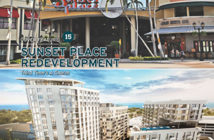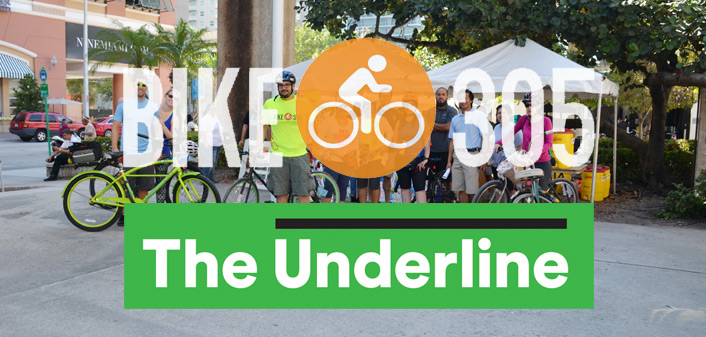The City of South Miami enjoys a somewhat modest inventory of architecturally and historically significant structures in the shopping and dining district. Thanks to the efforts of concerned City and County citizens, the preservation of structures representing the tastes, styles and concerns of those that came before us survive to provide our city with an identity uniquely its own.
Originally known as the Town of Larkins, the town center grew and prospered thanks in large part to the arrival of Henry Morrison Flagler’s Florida East Coast Railway (FEC). Established in Miami in 1896, the railway became essential to the prosperity of those pioneers who came to the region to establish homesteads, farm the land, and cut the timber. Businesses once served by unpaved trails, carts and even bicycles were provided a sophisticated and consistent rail link to ever-expanding markets.
The Town of Larkins was named for the head of one of the region’s pioneering families, Wilson Alexander Larkins (1860-1946). The Tennessee native, his wife Essie (c.1869-1948) and five of their children, settled in an area near current day Cocoplum Circle, ca. 1897. Eventually, Mr. Larkins owned scores of acres of farm land, operated a small dairy, the post office and a general store. With the coming of the rail line at what is now Sunset Drive and Dixie Highway, he added a commissary, packing house and railway siding. Larkins along with other growers and lumbermen purchased land closer to the FEC railway, and the center of the small settlement shifted westerly.
Families that settled or established businesses in and around the Town of Larkins: Dowling, Dorn, Opsahl, Galloway, Shelley, and Williamson, among others, helped to create a community in the wilderness south of the young City of Miami.
Brothers Harold and Robert Dorn from Chicago settled in the Miami area about 1910. “We came with farming in mind,” wrote Harold Dorn. And that they did–principally tomatoes, grapefruit, mangoes and avocados. In addition to buying land for warehouses near the railway, they also purchased real estate for commercial ventures that would provide services to the nascent town. Today known as the Amster Properties on the corner of Sunset Drive and South Dixie Highway, the three Dorn buildings have survived and retain most of their original architectural features. All are designated as historic structures: the Dorn-Martin drugstore (1925), the Bank building (1926) and the South Miami Post Office (1926).
The three buildings form a unit and wrap around the corner, forming part of the historic gateway that introduces the eastern entrance to South Miami Town Center from US 1. These efforts by the Dorn brothers were part of a regional building boom-let that was followed by the devastating hurricane of September 1926—a record-breaking storm that ravaged much of the new construction here and in the City of Miami (Miami’s unprecedented growth was worth about $60 million dollars in 1925).
The Dorn brothers also built the lush Riviera Theater on US1, which became part of the Fuchs Baking Company (later Holsum Bread) in 1934. Charles T. Fuchs, Jr. had moved the baking company north from Homestead to South Miami in order to be closer to distribution markets. The bakery, a major economic engine for the city, was a fixture in the downtown for over four decades with its landmark water tower and warm, comforting aroma of freshly-baked bread wafting throughout the city.
According to the Miami News (1938), “The bakers of Holsum took over that super-super theater and set to convert it into something more practical, a super-super bakery.” The bakery was a very successful business and Holsum bread became, as the News reports, “The most popular bakery product in South Florida.” The Holsum Bakery grew in the state of Florida and even shipped bread to Puerto Rico, Cuba and Latin American countries.
The Riviera Theater was rendered in an exotic Moorish-style, typical of many theaters of the period. The building’s life as a fancy theater was short-lived. The role it played as the Holsum Bakery complex was its most profitable and memorable. A lot just east of the complex was converted into a park-like setting, and was splendidly decorated each Christmas. After Holsum left the area, the old bakery was razed and replaced by what was planned to be a large office, hotel and shopping mall complex (known as the Bakery Centre). A doomed project, only the mall was constructed. It closed in the late 1990s and was later replaced by The Shops at Sunset Place.
Five other buildings along Sunset have been designated because of the survival of their period architecture and of their historic significance. They include the 1948 Streamline Modern building on the corner directly across Sunset from the Dorn buildings. The building’s prominent “eyebrows” that wrapped around the exterior on the first and second floor levels were subsequently removed. It maintains enough of its period character to be worthy of designation.
The Dowling Building at 5875 Sunset Drive is rendered in a Commerical Masonry Vernacular style with ground floor arcade and a second floor that originally served as apartments. The old Opsahl store built in 1914 was incorporated into William Manning Dowling’s mid-1920s mixed retail and residential building.
Pioneers to what would become the Town of Larkins included the George Shelley family who arrived in the area in 1911. Their retail establishment was first built in 1926 as a one-story affair. Later, the family added a second floor to the building, again, with apartments in mind. The second floor once had a balustrade that served to gracefully tie the arcaded first floor to the second. Located at 5837 Sunset, the architecture is an example of the Mediterranean Revival style.
Two other Mediterranean Revival buildings grace Sunset: the D.J. Red at 5850 and a building simply referred to by its address, 5800 Sunset Drive, built 1923 and 1929, respectively. Both structures were originally designed as “mixed-use” building that allowed for retail on the first floor and residences on the second. A later addition to the D.J. Red Building in the 1940s extended the structure along SW 58th Court. Through time, a number of restaurants have operated in the Red building, including the Waffle Shop and JJ’s American Diner. Today, two establishments, Irish Times and Barceloneta are located here.
The architecture along Sunset Drive represents an array of styles, from the Sylva Martin building’s simple bungalow plan (located on the City Hall campus), and the Mid-Century Modern design of the Crossroads building on the corner of Red Road to the charming wooden cottage known as the Doc Thomas House located across Red Road just beyond the western city limits.
The Sylva Martin Building, named in honor of former city clerk, Sylva G. Martin (1896 – 1988), is the only historically-designated structure owned by the City of South Miami. Constructed by the WPA in 1935 for use as a community center, this one-story masonry structure sports high-quality stonework fashioned from local oolitic limestone. Two bas relief cast panels above the central doorway by WPA artist Joan van Breeman depict scenes of children engaged in recreational activities. Through the years the building played an important role in the civic and social life of the area and remained an integral part of the city’s history. It served as a meeting place for clubs and fraternal organizations, a hurricane shelter, polling place, public library and USO-style entertainment center. Today it functions as an extension to City Hall, providing space for offices and City staff.
The Crossroads building at 5700 Sunset Drive was constructed as a shopping center, “Where Town and Country Meet.” Firmly planted in the streetscape, this landmark wraps around the corner, sporting a false tower rising above the building’s two stories. Designed in 1955 by M. Tony Sherman and Associates, this Modern, mid-century structure embodies the post-war exuberance for the “atomic age,” reflecting a belief in a righter future.
The Tropical Audubon Society (TAS) has been responsible for the home and land bequeathed to them by the owner, Arden Hayes “Doc” Thomas (1887–1975). Constructed in 1932, the rustic 1,400 sq. ft. cottage designed by architect Robert Fitch Smith is built of red tidewater cypress, with oak, walnut, mahogany, and Dade County pine interiors.
Historically-designated by Miami-Dade County, “the Doc Thomas House is perfectly situated in the South Miami Community to serve as a location to educate the public on environmental issues, engage citizens in helping to improve our quality of life through planting natives, attracting wildlife and restoring and connecting greenspace,” said TAS Executive Director Laura Reynolds.
South Miami’s shopping and dining district boasts a range of historic architecture spanning from 1914 to 1955. The Sylva Martin and Doc Thomas structures frame the visual experience that define two major periods of construction activity: the optimistically-charged building booms of the 1920s and the Post World War II era.
Next time you are enjoying our Town Center, take a moment to reflect on our city’s history and its architectural past—things may take on a new meaning for you.
[rev_slider HistoricArchitecture]


